by Amineddoleh & Associates LLC | Oct 28, 2024 |
Art and artifact collectors, like the objects they possess, come in all shapes and sizes. Some collectors seek wood carvings, or lithographs, paintings, dolls, memorabilia, stamps or coins. A lesser-known obsession for some collectors, however, are those objects that have paranormal pasts, haunted histories, or cursed beginnings.
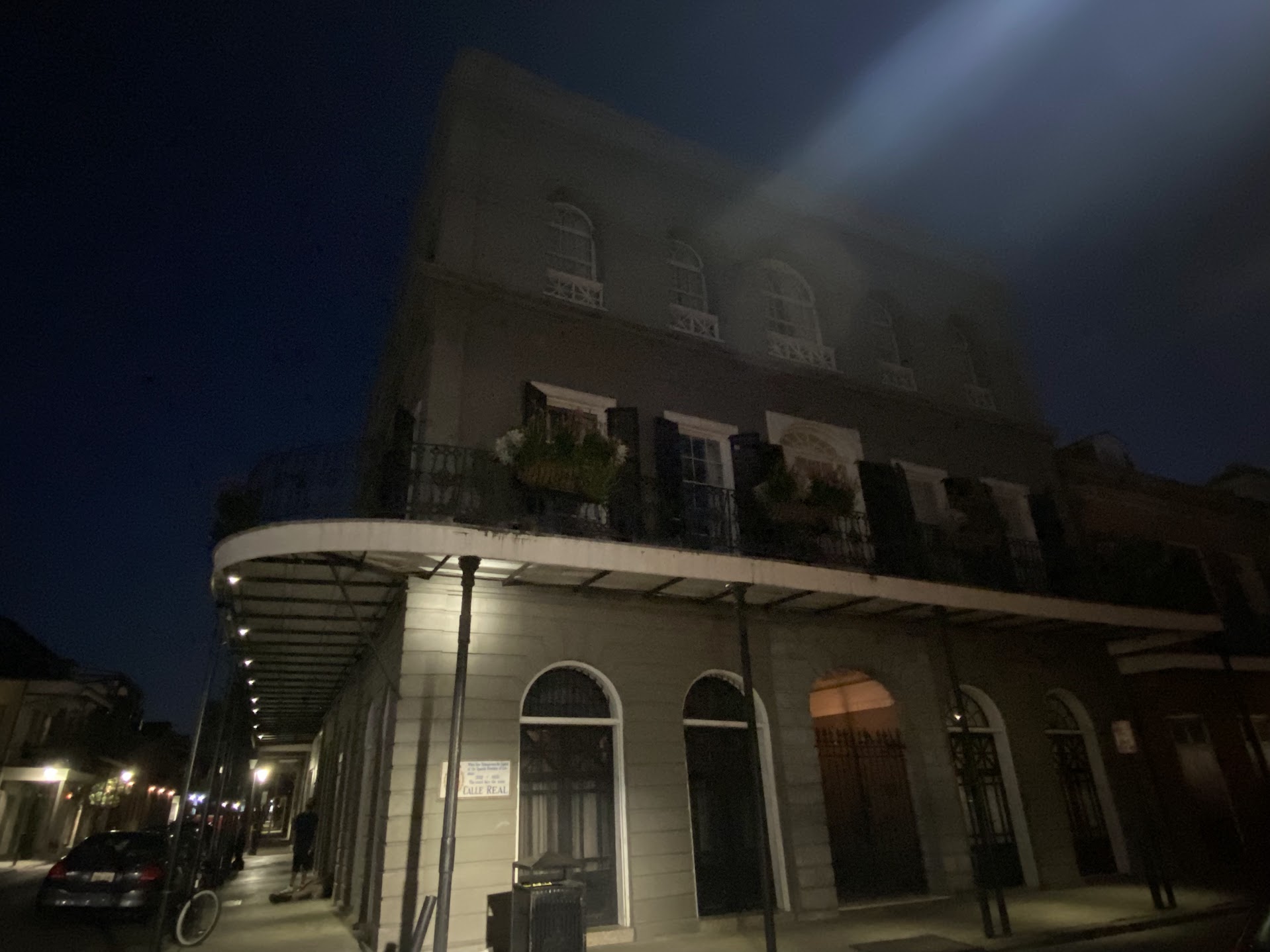
The former New Orleans mansion of alleged serial killer Marie Delphine Macarty or “Delphine LaLaurie.” Are those ghosts in the windows? Photo copyright: Leila Amineddoleh
One collector of the macabre is the always eccentric and very talented Nicholas Cage, an actor extraordinaire who has made headlines with his haunted purchases. One of the most famous, a haunted New Orleans mansion of a former female serial killer, was just sold again – this time for $6 million. The house has exchanged hands frequently since arson investigators uncovered a human graveyard in the attic. The killer, socialite Delphine LaLaurie, supposedly murdered countless slaves in the house in the 1800s before fleeing (allegedly to France) during a fire in 1834. The house has been featured in shows like American Horror Story and is the stuff of local legends. It has been called the most haunted house in America.
Nicolas Cage also drew attention for the construction of a pyramid-shaped tomb in a haunted New Orleans cemetery. The pyramid, which some say resembles the logo of a famous Cage film National Treasure, has been the subject of fierce controversy among locals since its installation. Some say the actor made secret deals with the Catholic church to destroy the historic graves underneath and install the tomb. Regardless, the tomb is seen as a kind of sacrilege to local historians who have struggled to preserve the historic St. Louis Cemetery No. 1. But Cage doesn’t seem fearful of spirits. In fact, he even slept in Dracula’s Castle while in Romania.
Another famous long-time collector is John Zaffis. He shares a similar fascination with haunted objects and locations. Zaffis is the director of the Paranormal Research Society of New England, host of the former SyFy show, Haunted Collector, and the owner and curator of the Museum of the Paranormal. Objects at the museum range from an antique clown, to a grandfather clock, to The Book of Shadows. All artifacts have a creepy, haunted, or cursed provenance.
Not surprisingly, Las Vegas is also home to a Haunted Museum full of notoriously haunted objects. The museum is curated by American paranormal investigator Zak Bagans and holds something called the Devil’s Rocking Chair and a cursed wine cabinet called “The Dibbuk Box.” That cabinet inspired a book by the same name. The true story, written by the curator of a Missouri medical museum, Jason Haxton, details the terrifying series of events that unfolded after he purchased the box on Ebay. The box, said to be inhabited by a spirit, was also the inspiration for the Hollywood film Possession.
Famous (yet controversial) paranormal investigators Ed and Lorraine Warren who inspired the Conjuring were also collectors of haunted objects. The Warren Occult Museum is said to hold the original “Annabelle” doll and other objects, although reviewers say the entire experience is a scam. However, their “Annabelle” doll isn’t the only one with reported powers.
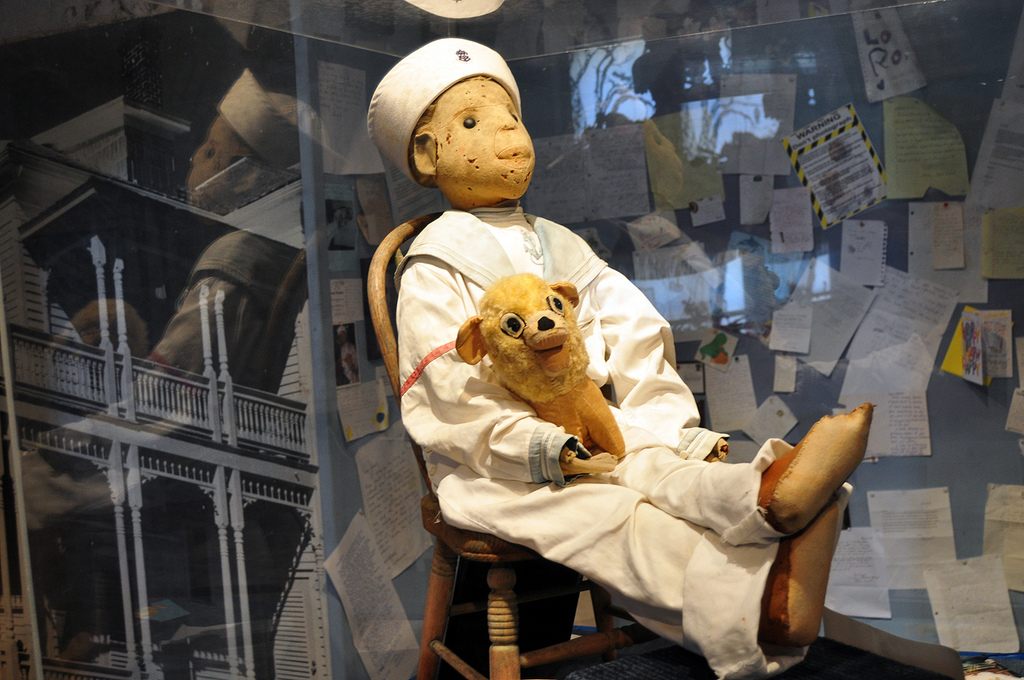
Robert the Doll reclines in a chair. Courtesy: robertthedoll.org
“Robert the Doll” has been haunting people’s imaginations (or realities…) for decades. He was created at the turn of the century in 1904 by the Steiff Company who gifted the doll to a Key West boy named Robert Eugene Otto. The doll stands around 40 inches tall and is filled with wooden wool. It once was painted with features similar to a jester, but over time those features have been worn away. Robert the Doll is dressed in a sailor outfit that once belonged to Otto.
Otto developed a unique relationship with the doll. Reportedly they were “best friends” growing up. Local lore says voodoo played a large part of Otto’s formative years, which may play into the doll’s alleged mystique. During that time, Robert the Doll was said to be involved in “strange and somewhat alarming events.” Otto’s parents often heard their son speaking to the doll and getting responses back in a totally different voice. Robert also supposedly changed his expressions when Otto spoke to him.
Despite disturbing stories of his childhood, Otto grew to become a prominent artist and designed the art gallery at the Fort East Martello Museum in Key West. The doll remained with Otto throughout his life, and stayed with Otto at his residence called the “Artist House.” Otto’s wife was reportedly frightened of the doll and banished it to the attic. Soon after, neighborhood children report seeing the doll looking out the window and mocking them as they walked by. Still today, visitors to the Artist House allege hearing footsteps in the attic and childish giggling.
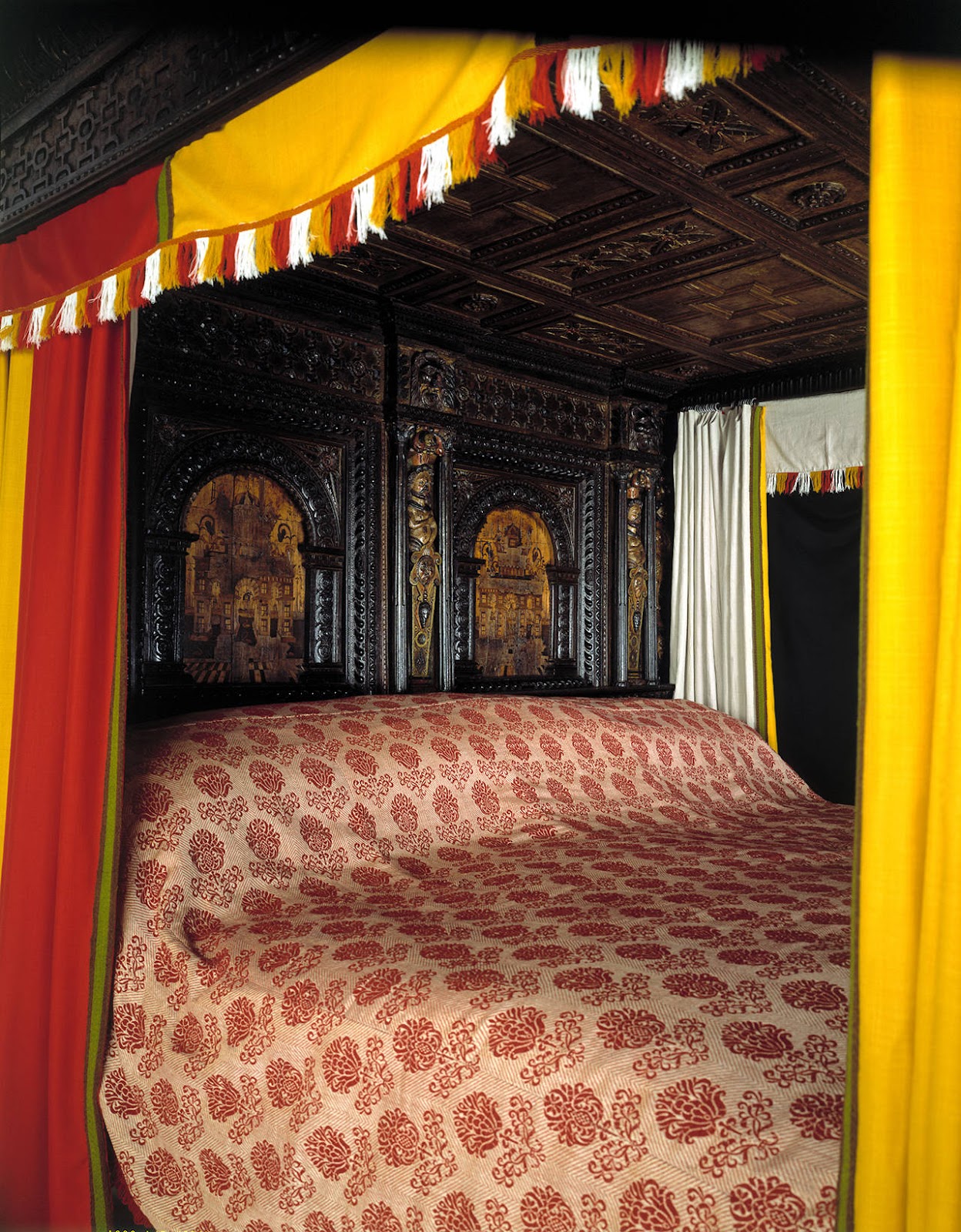
A close-up of the Great Bed of Ware. Courtesy: Victoria and Albert Museum
Haunted objects aren’t just kitsch, but they have made their way into world-class museums. The Great Bed of Ware at the Victoria & Albert Museum in London is another allegedly haunted object. The bed, constructed around 1590, was most likely made as a tourist attraction for an inn in Ware, Hertfordshire. Guests carved their initials in the wood or applied red wax seals to mark their stay in the bed, all of which are still visible today. It is said, however, that the bed’s occupants did not find much rest. The carpenter that built the bed supposedly haunted any non-royal guests who seek rest under its canopy. Guests would allegedly find themselves scratched, pinched, and beaten about. Some even woke up with bruises.
The Great Bed of Ware is unusually large. The flamboyant design, typical of the late-Elizabethan period, includes various Renaissance symbols like acanthus leaves, strapwork, lions, and satyrs. Figures carved in the headboard and underside of the wooden canopy have traces of paint, which indicate that the bed may be brightly colored.
The first mention of the bed in literature was in 1609, when Ben Jonson referred to it in his Renaissance comedy Epicoene. The bed was even mentioned in Shakespeare’s Twelfth Night when Sir Toby Belch describes a sheet of paper as “… big enough for the Bed of Ware!” The object is the most expensive to be purchased by the museum, and it still attracts curious onlookers today.
This Halloweek, we hope you enjoyed some collections of spooky and possessed. We implore you to read some more of our blog posts about cursed provenance, if you dare. Happy Halloween from Amineddoleh & Associates LLC!
by Amineddoleh & Associates LLC | Jul 9, 2024 |
Spain’s most exciting art exhibition of the summer is not in Barcelona. It’s not even in Madrid. Instead, the summer’s hottest art excursion is in a deconsecrated and incomplete cathedral in Alba de Tormes, a small town that is a two-hour drive from Madrid.

Alba de Tormes. Image courtesy of Frayle via Wikimedia Commons.
El Esplendor de La Pintura en Valenica
The exhibition, titled El Esplendor de La Pintura en Valenica (The Splendor of Painting in Valencia), highlights artists from Valencia in the late 15th and early 16th centuries. It demonstrates how the arrival of Italian and Flemish artistic influences at this time provided the spark needed to set the Spanish Renaissance ablaze. (Note for readers under the age of 16: Valencia is not just an Instagram filter – it’s also a beautiful municipality in Spain!)
This breathtaking exhibition features a monumental 120 pieces of Renaissance works, 90% of which have never been on display. Nothing like this has ever been accomplished in Alba before – and the exhibition’s success has made the international art world pay attention.
Two primary aspects of this exhibition make it stand out. The first is that the art on display is remarkable. The focal point of the exhibition is a painting of Christ tied to the pillar by Juan de Juanes. It is largely regarded as his best work, as well as a true pillar of the Spanish Renaissance canon. The painting is accompanied by an augmented reality rendition of the prized work. In an immersive video located in a nearby booth, viewers are treated to a life-like vision of Christ suffering. Christ stares soulfully into the eyes of the viewer, while tilting a head made heavy by a crown of thorns, and lifting bound wrists. This effect is powerful – and enough to send even the most pious attendees scurrying to Mass.
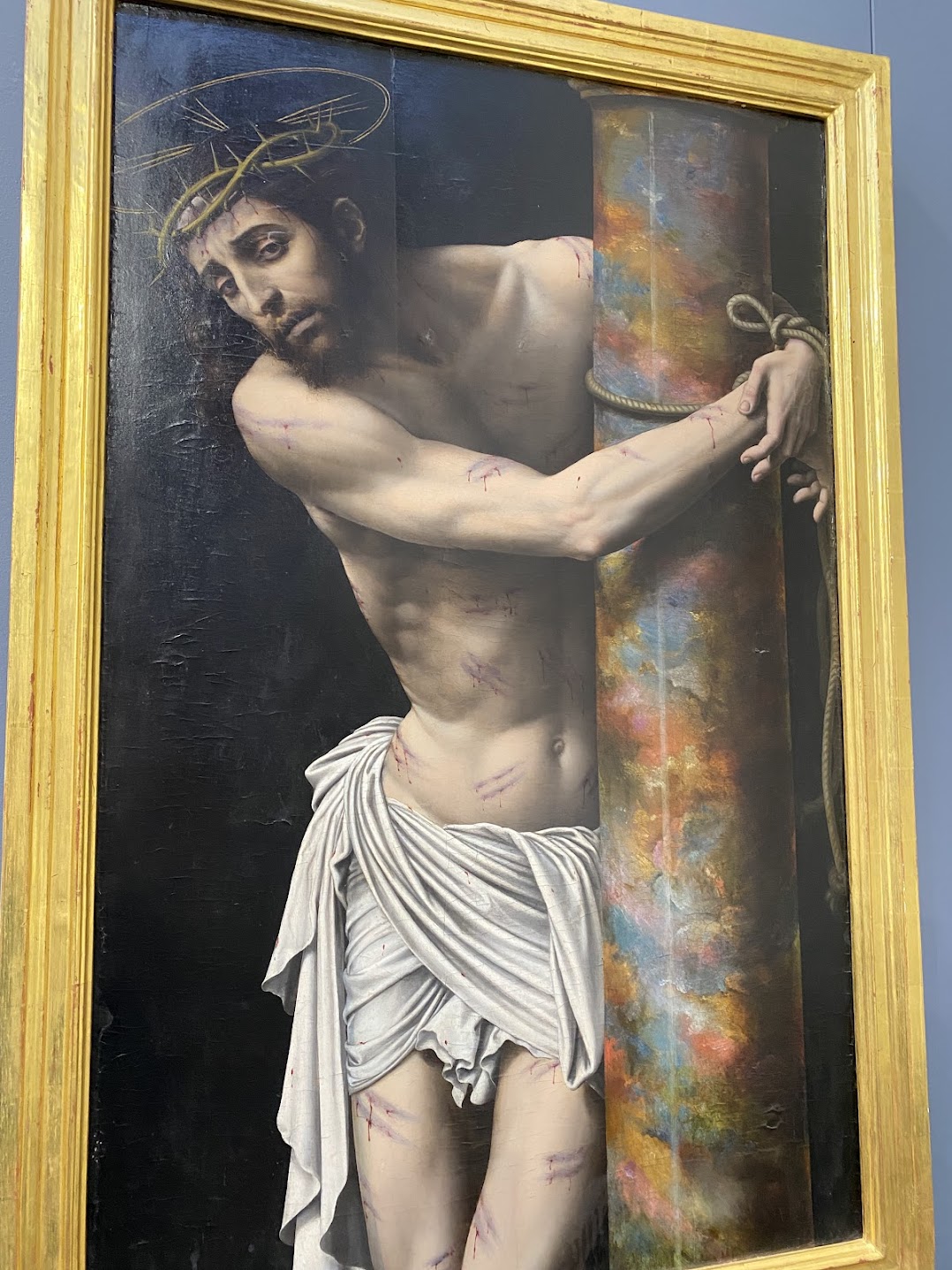
“Christ tied to the Column” by Juan de Juanes. Copyright: Leila A. Amineddoleh
In addition to Juan de Juanes’ pivotal work and its augmented reality counterpart, other priceless works fill the cavernous space. One wonders how such a thoughtfully curated collection came together. Many works are on-loan from private collections (the centuries-old altarpieces, for example, are a particular coup and a true treat for the senses). In fact, the collection is so triumphant in its significance and rarity that it alone makes a trip to Alba a definite “must” for anyone in Spain this summer. Which leads to the second reason this exhibition is garnering so much buzz in the art world.
Alba is a beautiful city, known for being a haven for painters and artists in the 16th century (who all flocked to bask in the aura of the ineffable Duke of Alba). Not only that, Alba is known for housing renowned Catholic saints St. Teresa of Avila and Saint John of the Cross. Despite all of this history, the city is still rarely considered a tourist site.
Tourism and Depopulation
The decision to hold the exhibition in Alba, then, was a response to what’s known as la España vaciada or “hollowed-out Spain.” This term is used to describe the depopulation happening across the country of certain areas. As citizens leave rural areas in favor of big city life, smaller towns face a host of problems: unemployment issues, reduced or eliminated services, closed restaurants and shops, and desolate downtown urban areas. But one unfortunate side effect less-frequently talked about is the threat depopulation poses to art and cultural heritage.
Our founder wrote a well-informed (and prescient) note on this topic (available here). But for those who are new to the subject, the depopulation of culturally rich areas puts the art and cultural heritage left behind at risk of theft, environmental destruction, and intentional or accidental demolition – just to name a few. Abandoned cultural sites and works of art are easily targeted by looters and bored civilians alike. The result is the heartbreaking loss of irreplaceable worldly treasures.

The Colosseum in Rome is a heavily-touristed site. Image via Fodor’s, available at https://www.fodors.com/world/europe/italy/rome/experiences/news/photos/the-10-best-ancient-sites-in-rome.
One solution to this damage that comes from depopulation is to re-direct tourism to these areas from highly popular sites. When tourism booms in the same areas over and over, a whole host of other issues ensues (Our firm has written at length on that topic here – click to brush up on the dangers of overtourism, including destruction of cultural sites due to wear-and-tear, as well as vandalism).
When tourism is instead spread out to more places, the risks to cultural heritage from overtourism are mitigated. Moreover, the economic benefits of tourism – and the boom it can provide to local economies – is more evenly spread out around the country.
This move to a more sustainable form of tourism does not happen naturally. Rather, it requires concentrated efforts from dedicated groups and individuals on the front lines. Immersive knowledge of a place and its most significant features are essential to breathing life into new spaces, in order to create new patterns of tourism.
Reliance on Local Experts
Nicolas Cortés, a 30-year veteran of the art world, is one of these individuals, and an organizer of the Valencia exhibition. His vision for this particular effort was, in his words, to expose people to high-quality art, as well as to the beautiful city of Alba itself. For Cortés, “it’s also about the environment. We want people to come to beautiful places [like Alba de Tormes] so they can get to know them.”

El Monasterio de la Anunciación de Nuestra Señora de Carmelitas Descalzas de Alba de Tormes. Image courtesy of Fundacion Declausura.
Cortés’s work is particularly important in Spain, where lack of Spanish involvement in international treaties has led to a disinterest in the international art world over the protection and preservation of Spanish artistic treasures. Additionally, many of the art and cultural heritage at-risk due to depopulation is held by the Church, and thus out-of-reach for State actors.
This is why the Valencia exhibition is such an artistic powerhouse – bringing culture to an area experiencing the negative impacts of depopulation, in a way that draws upon locals to help with daily operations and revitalizes the town’s economy. It features artists such as Gonçal Peris, Joan Reixach, Maestro de Artés, Yáñez de la Almedina, Martín Gómez, Paolo de San Leocadio and (of course) Juan de Juanes. In the words of the exhibition’s curator, José Gómez Frechina, the arrival of foreign works in Valencia “struck the city like a bolt of lightning, illuminating the way for all the painters there”. The resulting exhibition is a lighting strike itself. In short, it is worth a two-hours’ drive from Madrid.
Efforts Made by Turkey
Spain is not the only international location using tactics like this to divert tourists from over-touristed areas, In Turkey, for example, Istanbul’s city-wide restoration teams have painstakingly restored new attractions to bring tourism to little-known historical and cultural sites in the city.

Gülhane Park Cistern. Image courtesy of thebyzantinelegacy.com.
Istanbul is ripe to benefit from shifting tourism patterns (fun fact: Istanbul is currently the #1 most-visited city in the world), because Istanbul is a city of multiple layers. This means that there is always something new for the city to feature – and for tourists to discover. Most tourists rush to the Basilica Cistern upon arrival, as the city’s most famous cistern. However, just a 12-minute walk away is the Gülhane Park Cistern, a 1,500-year-old reservoir that has been restored by the city and recently reopened to the public in 2023. The Gülhane Park Cistern is ensconced inside a gorgeous green area that was once part of the private Topkapi Palace (also home to the Column of the Goths, a Roman monument, and the Alay Köşkü, a former favorite hang-out of 16th century Ottoman sultans).
By directing tourists to these, lesser-known but highly-valuable cultural sites, the municipality is able to relieve the burden of overtourism to a site like the Basilica Cistern – while still providing a memorable and invigorating experience to the visitors.
Sustainable Tourism
Dedicated efforts like these by cities and municipalities (when possible) and by individuals and nonprofits (when applicable) serve to mitigate the impacts of overtourism to popular sites. They also aim to correct issues caused by depopulation of rural areas. The combined impact protects cultural heritage on two fronts – providing a wonderful model for sustainable tourism moving forward.
Plus, who needs another photo of the Trevi Fountain? This summer, all the cool kids are at the Valencia exhibit in Alba – just check our firm’s socials for proof.
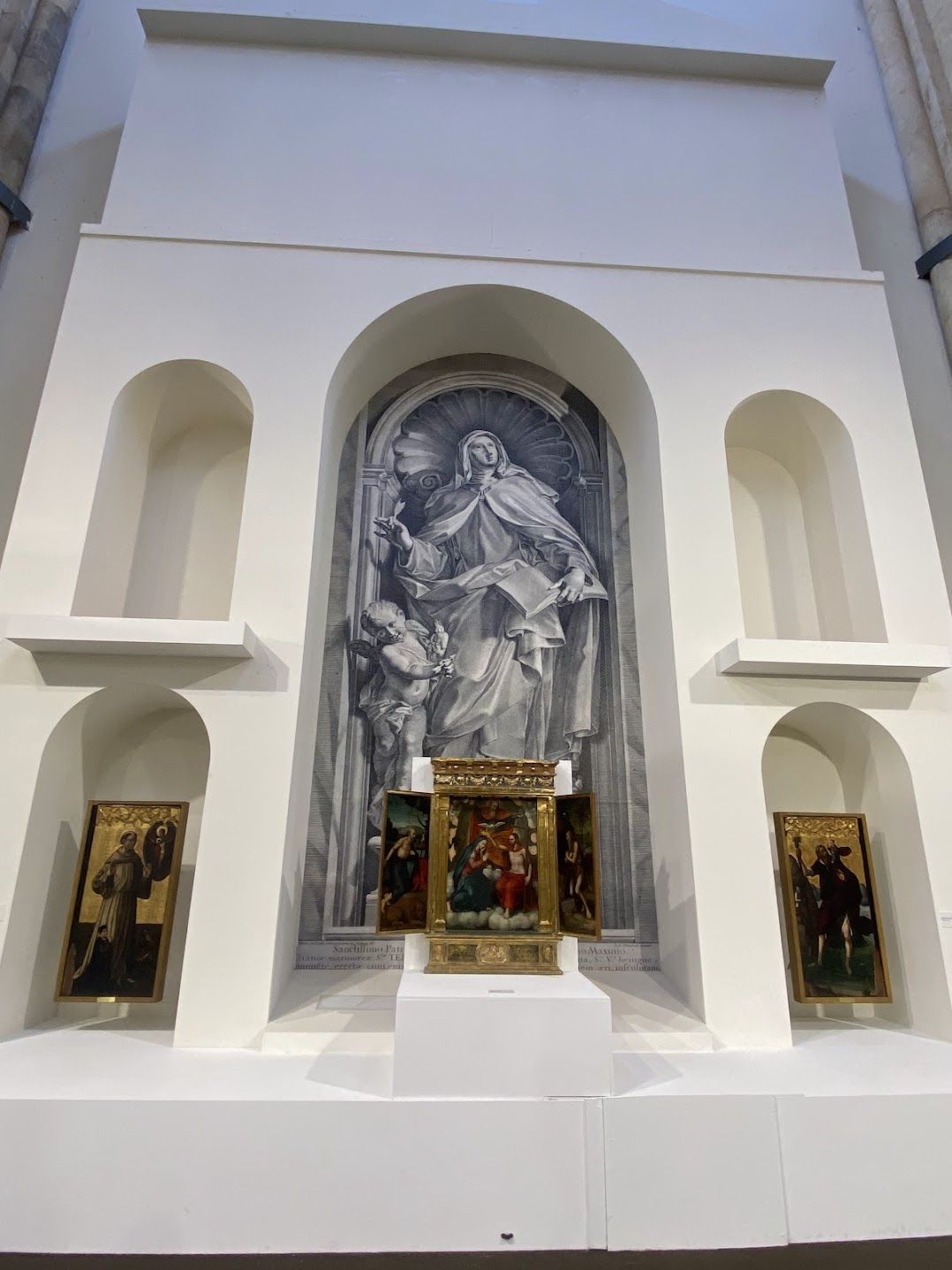
Altarpiece at El Esplendor de La Pintura en Valancia. Copyright: Leila A. Amineddoleh
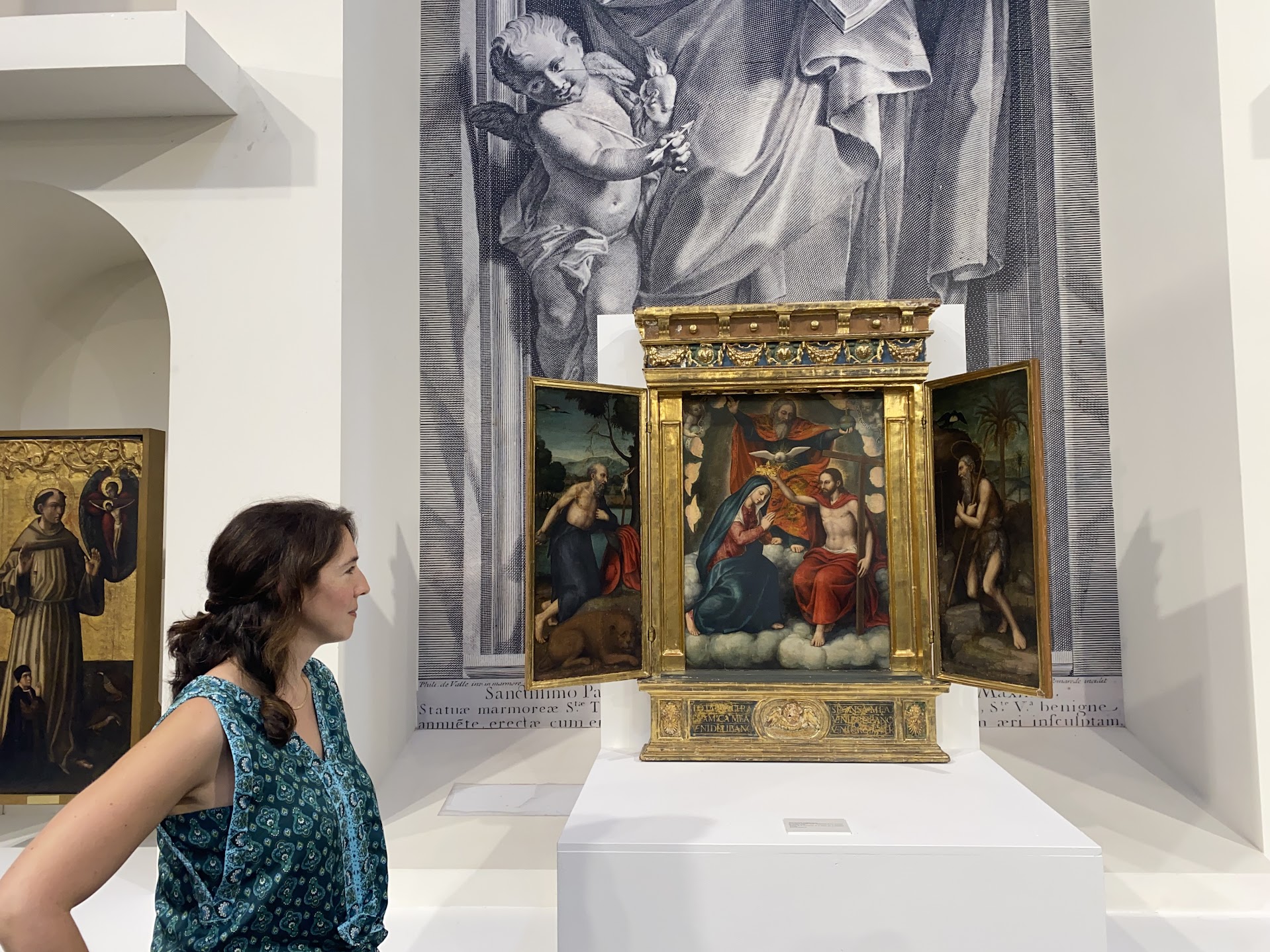
Our founder at the opening reception of El Esplendor de La Pintura en Valencia.
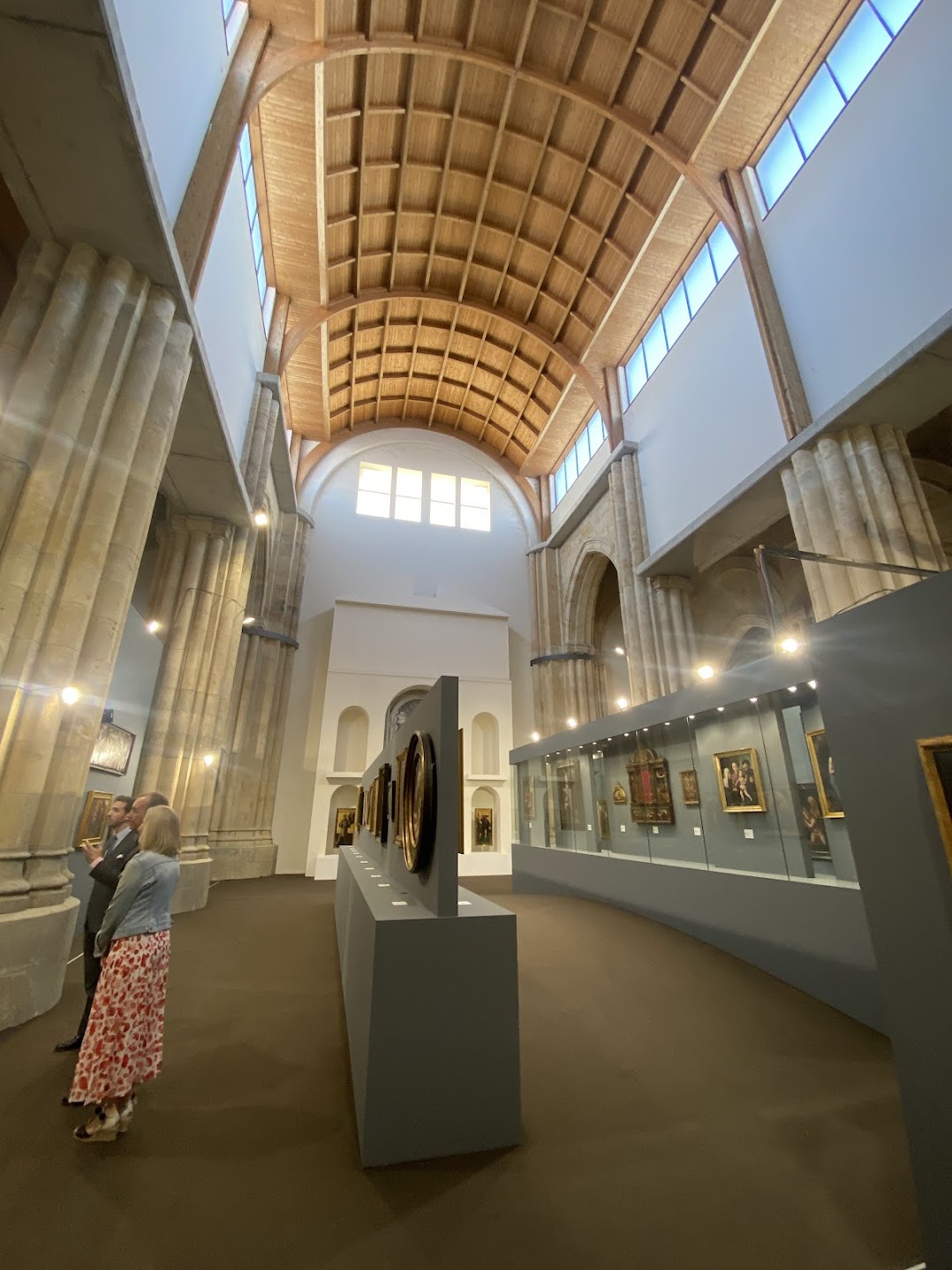
The Mayor of Alba de Tormes enjoying a tour of the exhibition. Copyright: Leila A. Amineddoleh
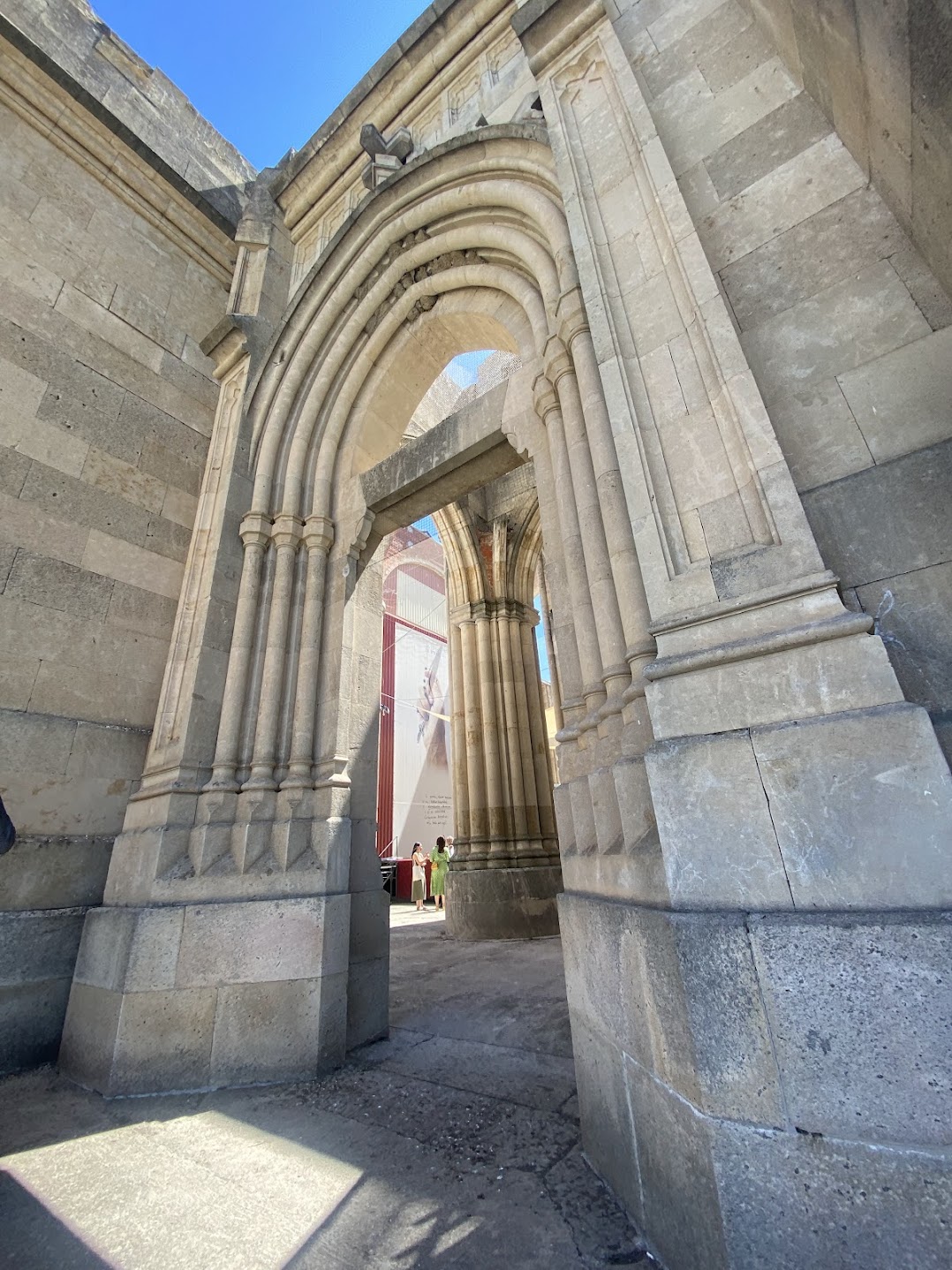
Entry to the exhibition. Copyright: Leila A. Amineddoleh
by Amineddoleh & Associates LLC | May 15, 2024 |
Last week, a painting stolen over forty years ago was finally returned to its original owner, Chatsworth House. The painting, A Double Portrait of Sir Peter Paul Rubens and Sir Anthony Van Dyck (1640s) by Eramus Quelliness II, was stolen on May 26, 1979, and recently discovered at a regional auction house in France. Chatsworth House lent the work to the Towner Art Gallery for an exhibition featuring works by the Flemish Baroque artist Anthony Van Dyck.

Eramus Quelliness II’s A Double Portrait of Sir Peter Paul Rubens and Sir Anthony Van Dyck (1640s). Image via Chatsworth House Trust.
“Smash and grab”
The exhibition did not go as planned. To the public’s astonishment, the gallery fell victim to a “smash and grab” raid after the exhibition. Thieves made off with A Double Portrait of Sir Peter Paul Rubens and Sir Anthony Van Dyck, but left more valuable works behind – causing authorities to believe that the robbery was not well-planned out. While A Double Portrait looked more expensive than the drawings left behind, the original Van Dyck drawings the thieves left were much more valuable (and have sold for upwards of $2 million in recent years).
The thieves may not have been very knowledgeable about art. Even so, they disappeared without a trace. The painting had been feared lost since that night in May 1979.

Interior of Chatsworth House. Image via Chatsworth House Trust.
Miraculous Recovery
Until now!
In 2021, an art historian discovered that the work was listed for sale in the bucolic town of Toulon, France. They reported the finding to Chatsworth House, who happily stepped forward to claim the work.
It’s unclear how the piece made its way from the thieves to modern-day France. The Art Newspaper reports that the painting was sent to Toulon to be sold after the seller discovered it while cleaning out his late parent’s house.
The painting required extensive restoration. Today, the work shines with its former glory.

Collectible from Chatsworth House. Image via Chatsworth House Trust.
The Art Loss Register
This was a happy ending to a devastating art robbery. Art crime continues to plague valuable collections in public and private collections all over the world. To combat the problem, the Art Loss Register (ALR) currently holds and maintains the largest private database of lost, stolen, and looted art, antiquities and collectibles.
Works are added to the registry on behalf of victims of looting and theft, insurers, police forces and other interested parties. ALR also employs a unique due diligence service for their clients who are active in the art market to ensure that they are handling objects that do not have questionable provenance.
The ALR single-handedly provides the art industry’s best risk management tool for those seeking to buy and sell works of art and cultural heritage. Moreover, using ALR’s tools and databases speeds up recovery of missing works, because searching the database enables users to identify works that have been stolen – and to return them to their claimant for recovery.
To read more about how ALR helps its clients search, register and recover lost art, click here.
by Amineddoleh & Associates LLC | Mar 23, 2024 |
In a highly-public withdrawal, Christie’s pulled four ancient Greek vases from auction. The four antiquities ranged in value from $7,000 to $30,000. It appears that the vases are the product of illicit dealings. They have been traced to the notorious antiquities trafficker Gianfranco Becchina.

One of the four disputed vases pulled from auction. Image via Christie’s.
Vases Traced to Notorious Dealer
Becchina, a well-known middleman in a looting network who was convicted for his actions in 2011, cosigned three of the four vases for a Geneva Christie’s auction in 1979. For the upcoming April 2024 auction, Christie’s listed the vases’ sale in 1979, but failed to disclose the fact that Becchina cosigned the objects. Dr. Christos Tsirogiannis, a lecturer at the Unviersity of Cambridge, called Christie’s nondisclosure “a trick used by the highest level. . . [t]hey deliberately exclude the connection of a trafficker in these three examples, although they’ve known about that connection for 45 years.”
Christie’s has released a statement counter to this effect, stating that the auction house “takes the subject of provenance research very seriously, especially when it related to cultural property.” However, taking the subject of provenance research seriously, and proactively allocating the resources and dedicated staff to carry out the work, are two different things.

A disputed vase pulled from auction. Image via Christie’s.
New Head of Provenance at the Met
In other antiquities news, the Metropolitan Museum of Art is taking a proactive stance. Last month, the museum hired Lucian Simmons (previously of Sotheby’s) as its first-ever Head of Provenance Research. This new position points to the museum’s recent efforts to increase the museum’s number of provenance-specific employees, in an era of greater scrutiny against both private and public collections. An increase in the number of restitutions has occurred during the past few decades, and this new hire makes the Met better situated to research provenance issues and handle requests for restitution. Mr. Simmons’ hiring brings the number of specialized province employees to eleven – an astonishing number for the institution.

Mr. Lucian Simmons. Image via Wilson Santiago/Metropolitan Museum of Art.
Mr. Simmons has extensive experience with provenance research and related issues, due to his long tenure at Sotheby’s. Since 1997, Simmons has developed and deployed transparent provenance policies for the auction house. In fact, transparency is at the heart of all of Simmons’ provenance work. He told to The New York Times that from the beginning of his time at Sotheby’s, he has “always tried to make sure [Sotheby’s was] very open” in the provenance research processes. Simmons intends to continue innovative model of transparency when he transitions to the Met this coming May.
New Awareness for Repatriation of Looted Antiquities
Repatriation actions for looted antiquities are increasingly being brought by countries around the world. Our firm has proudly represented and won legal claims related to looted antiquities on behalf of several nations, including the Republic of Italy and the Hellenic Republic of Greece. The cultural shift towards an increased awareness and respect for repatriation and restitution claims is something our firm both applauds and works to uphold.
by Amineddoleh & Associates LLC | Mar 5, 2024 |
In honor of International Women’s Day and Women’s History Month, our firm is reposting one of our favorite blog posts. This post originally ran on our firm’s blog in 2021.
—
It is a bitter truth that women, who are so often depicted, admired and romanticized through art, have had to overcome herculean obstacles to participate in its creation. In honor of Women’s History Month, this entry in our Provenance Series examines the work of the Old Masters’ female counterparts – the Old Mistresses – and their contemporary successors.
Rediscovery of Female Artists
Renaissance and Baroque works by women have deservedly entered the public consciousness in recent years. In 2019, a depiction of the Last Supper by nun Plautilla Nelli was installed in the Santa Maria Novella Museum in Florence, after a painstaking 4-year restoration by the Advancing Women Artists Foundation (AWA). The project was made possible through the AWA’s “adopt an apostle” crowdsourcing program: private financiers were allowed to “adopt” one of the life-sized disciples at $10,000 each (ever-unpopular Judas was instead funded by 10 backers at only $1,000 each). The oil painting, measuring 21 feet across, is one of the largest Renaissance works by a female artist still in existence. It is also the only work created by a woman during the Renaissance depicting the Last Supper.

Last Supper by Plautilla Nelli (prior to restoration). Image via My Modern Met.
The Provenance and Restoration of Plautilla Nelli’s The Last Supper
The Last Supper was likely created for the benefit of Plautilla’s own convent, the convent of Santa Caterina di Cafaggio in Florence, where it hung in the refectory (dining hall) until the Napoleonic suppression in the 19th century, when the convent was dissolved. It was thereafter acquired by the Florentine Monastery of Santa Maria Novella in 1817. Again, it was housed in the refectory until being moved to a new location in 1865. Scholar Giovanna Pierattini reports it was moved to storage in 1911, where it remained until 1939. It then underwent significant restoration, and returned to the refectory. It would remain on display there for almost forty years, surviving the historic flood of the Arno in 1966 with little damage. The work was next taken down in 1982, when the refectory was reclassified as the Santa Maria Novella Museum, and transferred to the friars’ private rooms. This is how the monumental work, which remained out of the public eye for centuries, is now visible to the public for the first time in 450 years.
Rossella Lari, the restoration’s head conservator remarks, “We restored the canvas and, while doing so, rediscovered Nelli’s story and her personality. She had powerful brushstrokes and loaded her brushes with paint.” The painting features emotionally charged expressions, emphatic body language, and exquisite details, such as the inclusion of customary Tuscan cuisine (roasted lamb and fava beans).
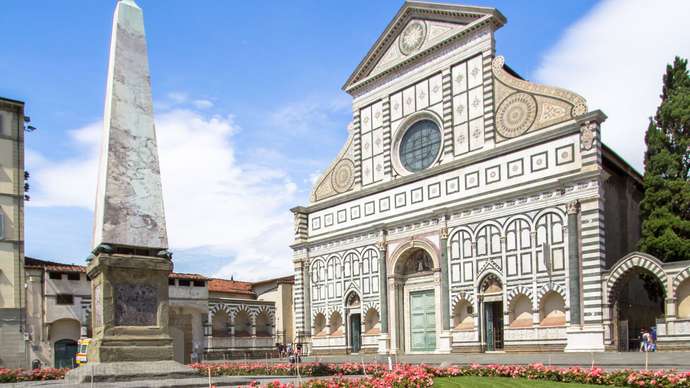
Santa Maria Novella in Florence, Italy. Image courtesy of CAHKT/iStock.com.
Plautilla’s use of color and composition is even more impressive when one considers that women were barred from attending art schools and studying the male nude; instead, they were forced to rely on printed manuals and the works of other artists. Plautilla was not only a self-taught artist, but she also ran an all-woman workshop in her convent and received the ultimate praise for an Italian Renaissance painter: inclusion in Giorgio Vasari’s seminal book Lives of the Most Excellent Painters, Sculptors and Architects. Notably, in Plautilla’s time the convent was managed by Dominican friars previously under the leadership of fire-and-brimstone preacher Girolamo Savonarola. The nuns were encouraged to paint devotional pictures in order to ward off sloth.
Undeterred, “Plautilla knew what she wanted and had control enough of her craft to achieve it,” says Lari. The Last Supper is signed “Sister Plautilla – Orate pro pictora” (“pray for the paintress”). Plautilla thus confirmed her role as an artist while acknowledging her gender, understanding that the two were not mutually exclusive. Although only a handful of the works survive today, Plautilla and her disciples created dozens of large-scale paintings, wood lunettes, book illustrations, and drawings with great focus, determination, and discipline. She is considered the first true woman artist in Florence and in her heyday, “There were so many of her paintings in the houses of gentlemen in Florence, it would be tedious to mention them all.” Since AWA’s conservation work was initiated, the number of works attributed to Plautilla has risen from three to twenty, meaning that other undiscovered masterpieces could be lying in wait.
Female-Led Museum Exhibitions
The Prado Museum in Madrid has hosted an exhibition featuring two overlooked Baroque painters, Sofonisba Anguissola and Lavinia Fontana, in an exhibition entitled “A Tale of Two Women Painters.” Meanwhile, the National Gallery in London hosted a show dedicated to Artemisia Gentileschi. Notably, Sofonisba, Lavinia and Artemisia all achieved fame and renown during their lifetimes, including royal commissions, only to be eclipsed for centuries after their deaths. Sofonisba was particularly sought after for her ability to capture the expressiveness of children and adolescents in intimate portraits, while Lavinia’s commissions displayed a more formal Mannerist style. Artemisia, the subject of the National Gallery’s first major solo show dedicated to the artist, is recognized as much for the strength of her figures in chiaroscuro as for her life story involving sexual assault and trial by torture. Despite considerable difficulties, Artemisia was able to succeed in a male-dominated field and created over 60 works, most of which feature women in positions of power. Artemisia is now hailed as one of the most important painters of her generation and an established Old Mistress in her own right.
Female Artists at Auction
Despite their long slumber in the annals of history, these artists are not only receiving attention in museums, but in auctions as well. In 2019, a painting by Artemisia depicting Roman noblewoman Lucretia shattered records when it sold for more than six times its estimated price at Artcurial in Paris. While estimates originally placed the work at $770,000 to $1 million, the painting was ultimately acquired by a private collector for $6.1 million. Lucretia was discovered in a private art collection in Lyon after remaining unrecognized for 40 years. It was in an “exceptional” state of conservation according to Eric Turquin, an art expert specializing in Old Master paintings previously at Sotheby’s.

Artemisia Gentileschi’s Lucretia (ca. 1630-1640). Image via Getty Museum.
The earlier record for one of Artemisia’s works had been set in 2017, when a painting depicting Saint Catherine sold for $3.6 million. That painting, a self-portrait of the artist, was then acquired by the National Gallery in London for $4.7 million in 2018. This was the first painting by a female artist acquired by the National Gallery since 1991, and the 21st such item in its entire collection, which encompasses thousands of objects. Saint Catherine had been owned by a French family for decades, but its authorship was obscured prior to its rediscovery and sale by auctioneer Christophe Joron-Derem. The painting was acquired by the Boudeville family in the 1930s, but the exact circumstances of this acquisition and the painting’s prior whereabouts were unclear. At the time of the National Gallery’s purchase, museum trustees raised concerns that the work might have been looted during World War II, although there is no firm evidence to support this suspicion. Despite the gaps in the works’ provenance, it was ultimately determined that the painting had been with the family for several generations and Saint Catherine was welcomed to her new home in London.
Recent Attributions
More recently, a painting of David and Goliath was attributed to Artemisia after a conservation studio in London removed layers of dirt, varnish and overpainting to reveal her signature on David’s sword. While the work’s attribution occurred too late for inclusion in the National Gallery exhibition, the owner is apparently delighted to discover the work’s true author and is keen to loan it to an art institution so the public can enjoy the work. This painting was originally acquired at auction for $113,000 and may have been owned by King Charles I – quite an esteemed pedigree and sure to raise its value by a considerable amount.
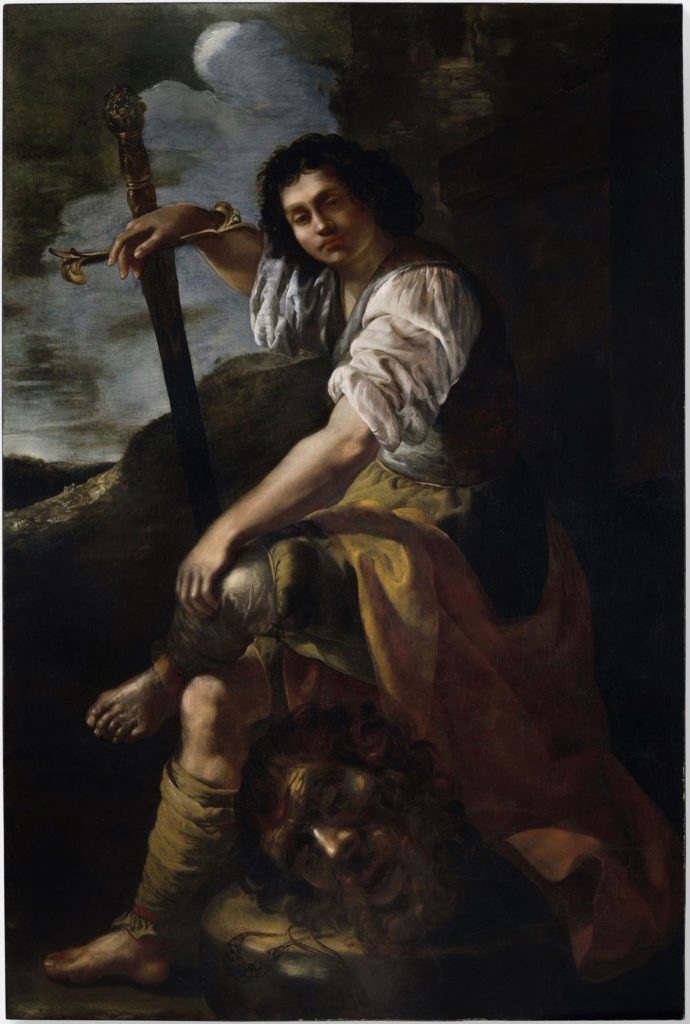
Artemisia Gentileschi, David and Goliath. Image courtesy of Simon Gillespie Studio.
In contrast to Artemisia’s ascendance, a painting once attributed to her father Orazio Gentileschi is now embroiled in controversy. That painting, which also depicts David and Goliath and described as “stunning” by the Artemisia show curator, has links to notorious French dealer Giuliano Ruffini. Ruffini is the subject of an arrest warrant due to his connection with a high-profile Old Master forgery ring operating in Europe. It is believed that the forgery ring, uncovered in 2016, garnered $255 million in sales, including works represented as being by Lucas Cranach the Elder and Parmigianino.
Although these paintings were widely accepted as genuine masterpieces and fooled leading specialists, they did not have verifiable provenances. The paintings were said to belong to private collector André Borie, although that was not the case and Sotheby’s was forced to refund money to buyers once the fraud came to light. The Gentileschi in question had been “discovered” in 2012 and sold to a private collector, who loaned it to the National Gallery in London. At that time, the painting was praised for its “remarkable” lapis lazuli background, but the museum did not conduct a technical analysis before displaying the piece. Despite several warning signs – the painting’s recent entrance into the art market, its unusual material, its similarity to another Gentileschi painting held in Berlin, and the lack of published provenance – the museum stated that there were “no obvious reasons to doubt” the painting’s attribution.
The forgotten nature of some female artists demonstrates that their talents are not rare, but rather that they lack the opportunities and publicity that male artists often take for granted. Once their talent is amplified, female artists are capable of great things. This pattern continues today.
The Modern Struggles of Female Artists
As famous female artists lost to history capture the public eye, they are joined by female contemporaries who share a similar struggle against underrepresentation. Women’s contribution to modern and contemporary art is often exemplifiedby those with ties to established male artists: Mary Cassatt (who achieved recognition as an Impressionist in Paris through her relationship with Edgar Degas); Georgia O’Keeffe (who entered the public eye via her relationship to Alfred Stieglitz); and Frida Kahlo (introduced to the art world by her husband, Diego Rivera). This truncated view ignores the vast amount of creative output generated by women, and reinforces the notion that recognition must be made through a male lens, a view prevalent during Artemisia’s time. It is worth noting that Artemisia’s father Orazio Gentileschi was her teacher and facilitator in the Baroque art market. In fact, this attitude has denied countless female artists of their deserving places in the canon of art history. It has even enabled surreptitious artists to take credit for works by others.
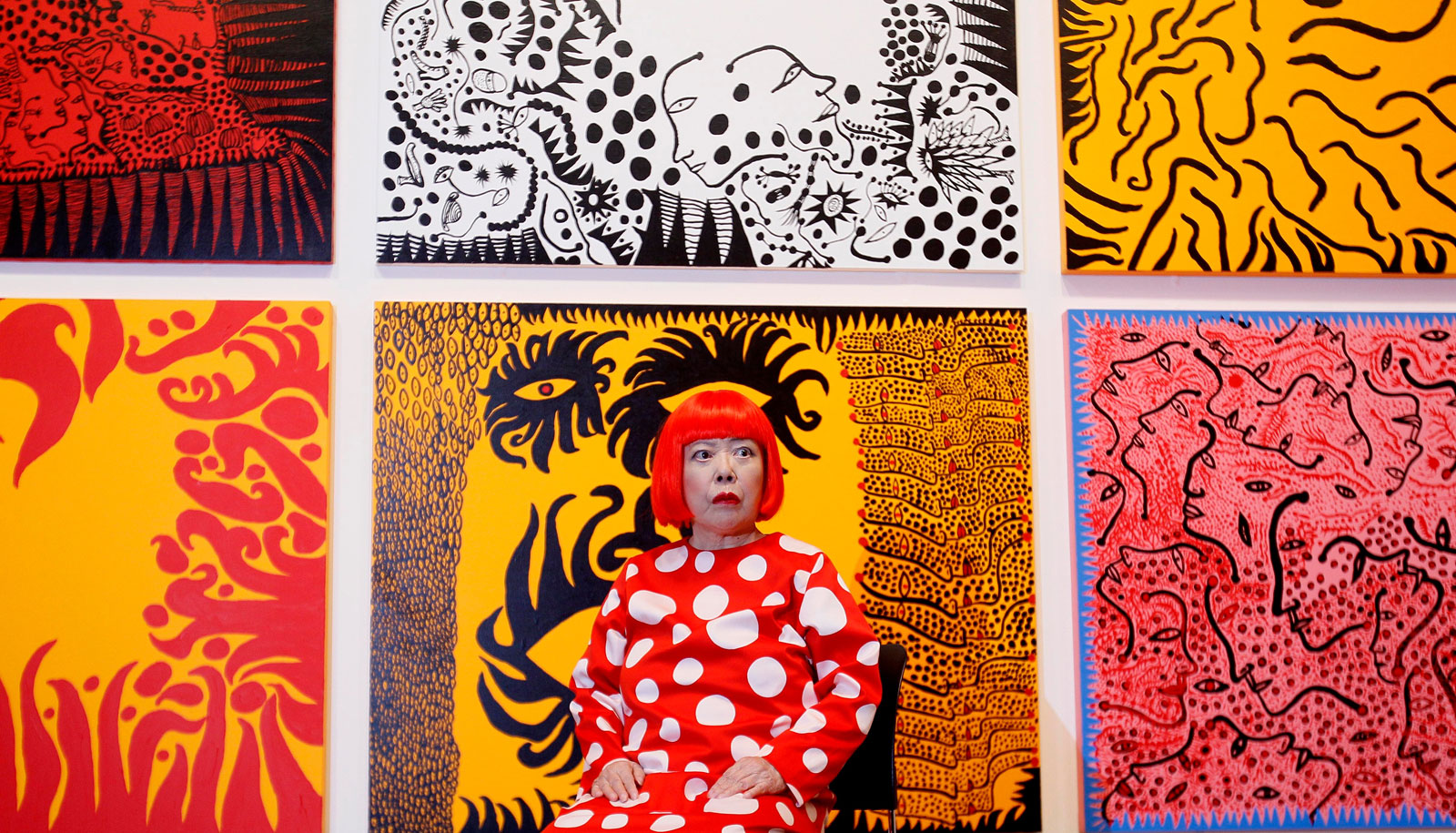
Yayoi Kusama.
Image courtesy of Kirsty Wigglesworth.
Today, Yayoi Kusama is a household name. The world’s top-selling female artist, she is renowned for her peculiar polka-dotted paintings and sculptures, which command long lines at preeminent art institutions across the globe. Like many famous contemporary artists from the last century, she is strongly associated with a unique personal style, and recognized by her bright-red wig. Despite her phenomenal success, her position in the pantheon of notable contemporary artists was anything but assured. Born in the rural town of Matsumoto, Japan in 1929, Kusama was discouraged from pursuing a career; rather, she was encouraged to marry and start a family. Frustrated by the constant efforts to suppress her artistic aspirations, she wrote to the already famous Frida Kahlo for advice. Kahlo warned that she would not find an easy career in the US, but nevertheless urged Kusama to make the trip and present her work to as many interested parties as possible.
Unsurprisingly, Kahlo’s advice was accurate. After traveling to New York, Kusama’s early work received praise from notable artists Donald Judd and Frank Stella, but it failed to achieve commercial success. Her work also attracted the attention of other renowned artists, who were able to channel ‘inspiration’ from Kusama’s work right back into the male-dominated New York art market. Sculptor Claes Oldenburg followed a fabric phallic couch created by Kusama with his own soft sculpture, receiving world acclaim. Andy Warhol repurposed her idea of repetitious use of the same image in a single exhibit for his Cow Wallpaper. Most blatantly, after exhibiting the world’s first mirrored room at the Castellane Gallery, Lucas Samaras exhibited his own mirrored exhibition at the Pace Gallery only months later. Needless to say, these artists did not credit Kusama for her work and originality. This ultimately caused a despondent Kusama to abandon New York and return to Japan.
Kusama spent the next several decades largely in obscurity. The frustrations in her career resulted in multiple suicide attempts and long-term hospitalizations. However, Kusama always found a way to channel this energy back into her art, and she continued to create art in various formats as a way to heal. It was not until a 1989 retrospective of her work in New York and an exhibition at the 1993 Venice Biennale that the world truly tok notice of her work. This global reintroduction was enough to galvanize interest in her artistic creation, leading to the success she enjoys today. While it may seem just that such a talented artist would eventually receive recognition for her work, this is not always a given and Kusama’s near erasure from the art world should not be discounted.
The Gendered Art Market Divide
In today’s art market, artists, collectors, dealers, and museums are making a concerted effort to fight this type of erasure. Kusama stands as a beacon to others, demonstrating that female artists can reach the pinnacle of their profession. However, it remains an arduous career path for many. Statistical analysis confirms that female artists are underpaid and underrepresented in both the primary and secondary art markets. For example, compare the highest price paid for a work by a living artist by gender: Jeff Koons’ Rabbit sold for $91.1 million in 2019; while Jenny Saville’s Propped sold for $12.5 million that same year, a mere 14% of the Koons’ price. Some of this disparity can be explained by the difference between men and women’s treatment in the workplace generally, but the art world is also subject to a number of particularities. Attributed to a host of causes, perhaps none is more prominent than women’s almost total exclusion from studio art until the 1870s. The art world has existed in this environment for so long that its institutions and relationships now mechanically reinforce the disparity between genders: women are less likely to receive recognition and training, and buyers are less interested in art created by females. The interest in female-made art is also disproportionality concentrated on its biggest names; the top five best-selling women in art held 40% of the market for works by women auctioned between 2008 and 2019. It has become a self-sustaining cycle that can only be broken through deliberate and effective action.
Initiatives Supporting Female Artists
Artists and galleries have been working to shine a light on the current landscape of inequality in the market. Groups like the Guerilla Girls have used their cultural status and notoriety to vocalize issues regarding sexism, racism, and other types of discrimination still rampant today. This type of radical-meets-reformer message resonates with a newer generation that is more vocal about addressing discrimination, and frustrated by the seemingly lackluster efforts to minimize their impact on society. In honor of Women’s History Month, several galleries have announced shows dedicated to addressing some of these issues. The Equity Gallery is presenting “FemiNest,” a collection of works by female artists centered around the literal and metaphorical ideas conjured by the idea of a “nest.” The show explores in sculpture, textiles, painting and other media the new spaces that have opened for women in recent decades and their practical and spiritual impact for women. The Brooklyn Museum has announced a retrospective of Marilyn Minter’s work titled “Pretty/Dirty” aimed at challenging traditional notions of feminine beauty. Featuring more than three decades of work, the show will track Minter’s progress throughout the 1970s, 80s, and 90s. The show is also part of a larger series of ten exhibitions by the Brooklyn Museum dedicated to the subject: “A Year of Yes: Reimagining Feminism at the Brooklyn Museum.” Lastly, the Zimmerli Art Museum will feature an exhibition of works by the Guerilla Girls and other female artists who have worked to depict women’s unequal treatment in the art world, “Guerrilla (And Other) Girls: Art/Activism/Attitude.” (For more information about these shows and others addressing similar issues, see here.)

Do Women Have To Be Naked To Get Into the Met. Museum? (1989), Guerrilla Girls. Image via the Met.
Although artists and art institutions have just begun the work of winding back centuries of discrimination, there is evidence that their work is already affecting the market. The percentage of female-generated artwork in the secondary market is increasing from year to year; from 2008 to 2018, the market more than doubled from $230 million to $595 million. Similarly, representation of women at major art shows is steadily, if inconsistently, increasing as well. This subtle shift in the market has been attributed at least in part to a new class of art purchaser: independently wealthy women, whose capital is self-made rather than inherited or shared via marriage. This novel source of demand is less sensitive to the traditional pressures of the market and is helping to fuel demand for works by female artists. Women’s History Month is an opportunity to reflect on the tremendous progress made by remarkable individuals in the art world, and to also contemplate the ripe opportunities that still lie ahead.























